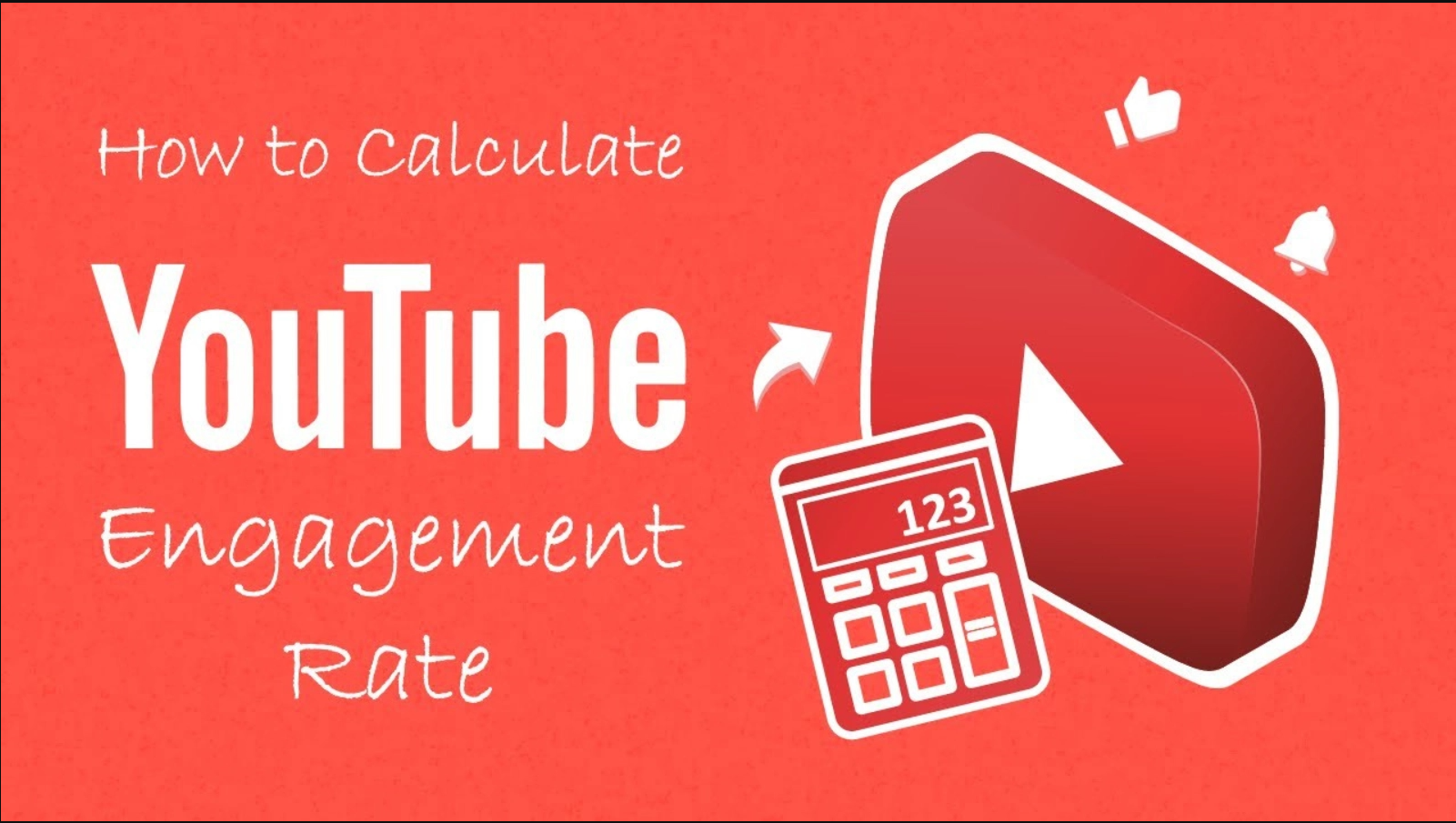Success on YouTube isn’t just about gaining subscribers and views; it’s about engaging with your audience and fostering a loyal community. The more engaged your audience is, the more likely they are to interact with your content, share it, and stay with your channel long-term. To truly measure your channel’s success, understanding and calculating your engagement rate is crucial. In this blog post, we will guide you through the use of a YouTube engagement rate calculator, explaining what it is, how it works, and how to use it to optimize your content strategy.
What is YouTube Engagement Rate?
The engagement rate is a metric that reflects how actively your audience interacts with your content. It goes beyond just views, giving you insights into the level of audience participation through likes, comments, shares, and other forms of interaction. High engagement rates typically indicate that your content resonates with your audience, which can lead to better visibility on the platform due to YouTube’s algorithm prioritizing engaged content.
Why is Engagement Rate Important?
- Algorithm Boost: YouTube’s algorithm favors content with high engagement, helping you rank higher in search results and suggested video feeds.
- Community Building: A high engagement rate shows that your viewers are not only watching your videos but also interacting with them, which strengthens your channel’s community.
- Monetization Opportunities: Brands and advertisers often look at engagement rates when deciding which creators to partner with. A higher engagement rate could lead to more sponsorship and partnership opportunities.
How to Calculate YouTube Engagement Rate
The formula for calculating the engagement rate on YouTube can vary slightly depending on which interactions you choose to include. A basic formula used by most YouTube engagement rate calculators is:
[
\text{Engagement Rate} = \frac{( \text{Likes} + \text{Comments} + \text{Shares} )}{\text{Total Views}} \times 100
]
This formula provides a percentage that reflects how much of your audience is actively engaging with your content.
Different Types of Engagement Rates
While the basic formula mentioned above works well, there are several types of engagement rates you can calculate based on your goals:
- Interaction Engagement Rate: Focuses on the number of interactions (likes, comments, shares) relative to views.
- Audience Engagement Rate: Measures engagement relative to the total number of subscribers rather than just views.
- Watch Time Engagement Rate: This type focuses on how long viewers stay engaged with your video compared to its total length.
Each of these rates offers unique insights into different aspects of your content’s performance, and using a YouTube engagement rate calculator can help you track and monitor them with ease.
1. Using a YouTube Engagement Rate Calculator
A YouTube engagement rate calculator simplifies the process of calculating your engagement metrics by automating the math. You simply enter your video’s total views, likes, comments, and shares, and the calculator does the rest. Many online tools are available for this purpose, allowing you to get a quick snapshot of your video’s performance.
Benefits of Using an Engagement Rate Calculator:
- Time-Saving: Manually calculating engagement rates can be tedious, especially when managing multiple videos.
- Accuracy: Automated calculators reduce the risk of errors in your calculations.
- Comprehensive Insights: Some calculators offer additional metrics such as subscriber growth and retention rates, giving you a more complete picture of your channel’s health.
By regularly using a YouTube engagement rate calculator, you can identify trends in audience behavior, see which videos perform the best, and adjust your content strategy to improve your engagement over time.
2. Optimizing Your Content for Higher Engagement
Now that you understand how to calculate your engagement rate, the next step is improving it. Increasing engagement involves not just creating high-quality videos, but also encouraging your audience to participate in meaningful ways. Here are some proven strategies to boost your engagement:
Create Engaging Thumbnails and Titles
The first interaction viewers have with your content is through your video’s thumbnail and title. Thumbnails and titles should be designed to grab attention and pique curiosity.
Tips for Creating Click-Worthy Thumbnails and Titles:
- Use High-Quality Images: Make sure your thumbnails are bright, clear, and visually compelling.
- Keep Titles Concise: Aim for titles that are both informative and intriguing without being too long.
- Incorporate Keywords: Use SEO-friendly keywords in your titles to help with search visibility.
Encourage Comments and Discussions
Engagement starts with interaction, and one of the best ways to get your viewers involved is by encouraging comments. Asking questions during your videos or leaving prompts in the description can motivate your viewers to engage.
Strategies to Encourage More Comments:
- Ask Open-Ended Questions: Prompt viewers to share their thoughts on a topic discussed in your video.
- Create a Call to Action (CTA): Encourage viewers to comment by asking for feedback or suggestions for future content.
- Respond to Comments: Show your audience that you value their input by responding to their comments and fostering discussions.
Utilize Calls to Action
One of the simplest ways to boost your engagement rate is by directly asking viewers to like, comment, and share your video. Including a clear call to action (CTA) in your videos, descriptions, and end screens can be very effective.
Examples of CTAs:
- “If you enjoyed this video, be sure to give it a thumbs up!”
- “Let me know your thoughts in the comments below!”
- “Don’t forget to subscribe and hit the notification bell for more content!”
Create Playlists and Series
Organizing your videos into playlists or creating a series encourages viewers to watch more of your content. Playlists can increase watch time and engagement by making it easier for viewers to find related videos.
Benefits of Playlists:
- Enhanced User Experience: Playlists make it convenient for viewers to consume multiple videos on the same topic.
- Increased Watch Time: When viewers get hooked on a series, they are more likely to stay on your channel for longer, increasing watch time and engagement.
3. Engagement Metrics Beyond Likes and Comments
While likes and comments are essential for calculating engagement, there are other metrics that you should consider tracking as well.
Watch Time and Retention
Watch time refers to the total time that viewers spend watching your videos, while retention measures how long viewers stay on a video before clicking away. High retention rates indicate that your content is engaging enough to keep viewers watching until the end.
How to Improve Watch Time and Retention:
- Structure Your Videos Effectively: Use a strong hook in the introduction to grab attention, followed by engaging content throughout.
- Add Visuals: Incorporate dynamic visuals, graphics, and transitions to maintain viewer interest.
- Keep It Concise: Cut out unnecessary information to keep your video focused and engaging.
Shares and Mentions
When viewers share your content on social media, they are not only engaging with your video but also helping to expand its reach. Videos that are widely shared are likely to have higher engagement rates as they are exposed to more potential viewers.
Tips to Encourage Sharing:
- Make Your Content Shareable: Create videos that resonate emotionally or provide significant value, encouraging viewers to share.
- Promote Sharing in Your CTA: Remind your audience to share the video with friends or on social media.
4. Monitor and Adjust Your Strategy
Regularly using a YouTube engagement rate calculator and tracking other engagement metrics is crucial for refining your content strategy. Analyzing your performance will allow you to identify which content is resonating with your audience and which areas need improvement.
Key Metrics to Track:
- Engagement Rate Trends: Use the calculator to see how your engagement rate changes over time.
- Audience Retention: Monitor how long viewers are staying on your videos.
- Subscriber Growth: Track whether higher engagement leads to increased subscriber numbers.
Conclusion
Measuring your success on YouTube goes beyond just counting views and subscribers. Your engagement rate offers a deeper understanding of how well your content is resonating with your audience. By using a YouTube engagement rate calculator, you can easily track your performance, identify trends, and optimize your strategy to increase engagement.
Whether you’re just starting out or looking to refine your existing channel, improving engagement is key to achieving long-term success on YouTube. Follow the strategies outlined in this post, and you’ll be well on your way to building a loyal, engaged audience while boosting your channel’s visibility and growth.




